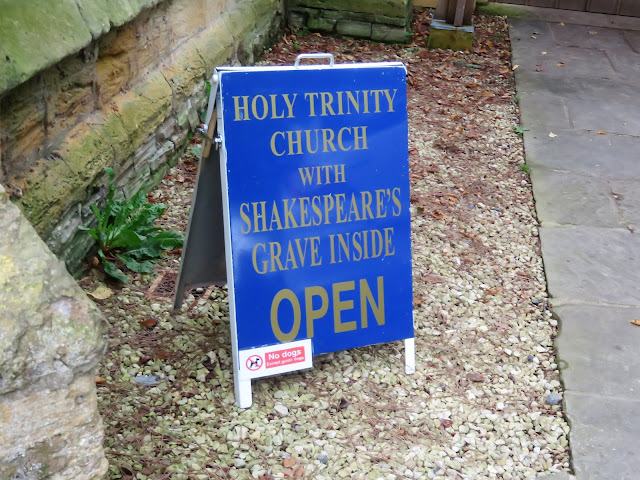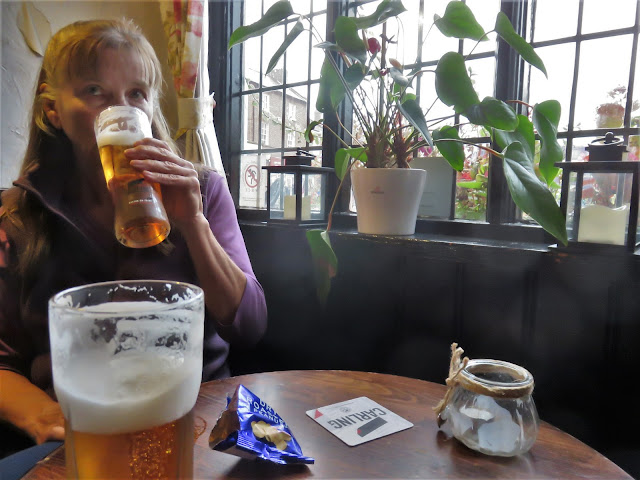Talk about a
city taking advantage of its history and its roots – apparently the single most
notable thing this town ever produced was William Shakespeare. It truly is all
about The Bard here. All the shops down
the main strip cater to the tourist, and capitalize on the Shakespeare theme,
in any way, shape, or form imaginable. Even though this part of being in a
tourist town doesn’t call to either one of us, we did enjoy the vibe of the
city center, the hub of activity, and the quaint look and feel of the
surroundings.
We walked along
the River Avon at different spots around the town, and enjoyed the parklike
settings and the riverboat RV’ers (which is what we dubbed them – it appeared
many people lived on their riverboats fulltime, much like we live full time in
our 5th wheel). Especially fascinating was the Stratford-Upon-Avon
canal, built between 1793 and 1816, which runs for 25 miles with a series of
Locks which lower and raise the water level on the river to allow boats to pass
through otherwise unnavigable shallow areas.
Of course
theater is a major industry in Stratford. The Royal Shakespeare Company, a
major British theater company, is based here, and employs over 1000 staff and
produces around 20 productions a year.
We took
advantage of the Hop-On/Hop-Off bus tour, making several stops along the
prescribed route, visiting all things Shakespeare.
Our first stop
was Church of The Holy Trinity, more often referred to as Holy Trinity Church,
or as Shakespeare’s Church, due to its fame as the place of baptism and burial
of William Shakespeare. More than 200,000 tourists visit the church each year.
The day we were there, it was rather peaceful, and not overly crowded with
tourists. The colors of fall were starting to show themselves, and we got a
tremendously good vibe walking the grounds, and touring the inside of the
church.
Our next stop
was Anne Hathaway’s Cottage. William Shakespeare and Anne Hathaway were married
in 1582 when Anne was 26, and William was 18, at which time she was already
pregnant with their first child. Prior to her marriage, it is believed she grew
up in this 12-roomed farmhouse with several bedrooms, and now set in beautiful
and extensive gardens.
Next stop was Mary
Arden’s Tudor Farm. Mary Arden was Shakespeare’s mother, and the youngest of 8
daughters born to Robert Arden and Mary Webb. The farm was built by Robert
Arden around 1514, and the house has been significantly altered over time. Today
visitors here can experience the sights, sounds, and smells of a working Tudor
farm as docents reenact the everyday experiences including woodworking, crafts,
cooking, falconry demonstrations, and raising animals and crops. Actors dress
in period clothing, talk in period talk, and try to recreate the environment
that may have existed in Mary Arden’s day.
Next stop, Shakespeare’s
Childhood home. Set in the middle of the city center and tourist section, it
was really hard to imagine the original surroundings in the 1500’s. The house
itself is relatively simple, but for the times it would have been considered
quite a substantial dwelling. John Shakespeare, William’s father, was a glove
maker and wool dealer, and the house was originally divided in two parts to allow
him to carry out his business from the same premises. Outside of this being
historically interesting, there wasn’t a lot about the house itself or its
current location that stood out.
Finally, we
stopped in at the Old Thatch Tavern for a farewell pint. This is a landmark 15th
century pub located in the historic heart of Stratford-Upon-Avon, and 300 yards
from Shakespeare’s birthplace. It became the brewery for the town in 1470, and
has been a licensed pub since 1623. It claims to be the oldest pub in
Stratford, and is the only thatched-roof property in Stratford’s town center.
Farewell to
Stratford-Upon-Avon, or should I say … “Good night, good
night! Parting is such sweet sorrow, that I shall say good night
till it be morrow”.













































No comments:
Post a Comment